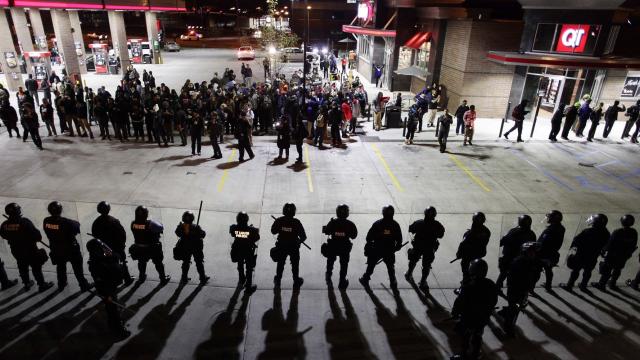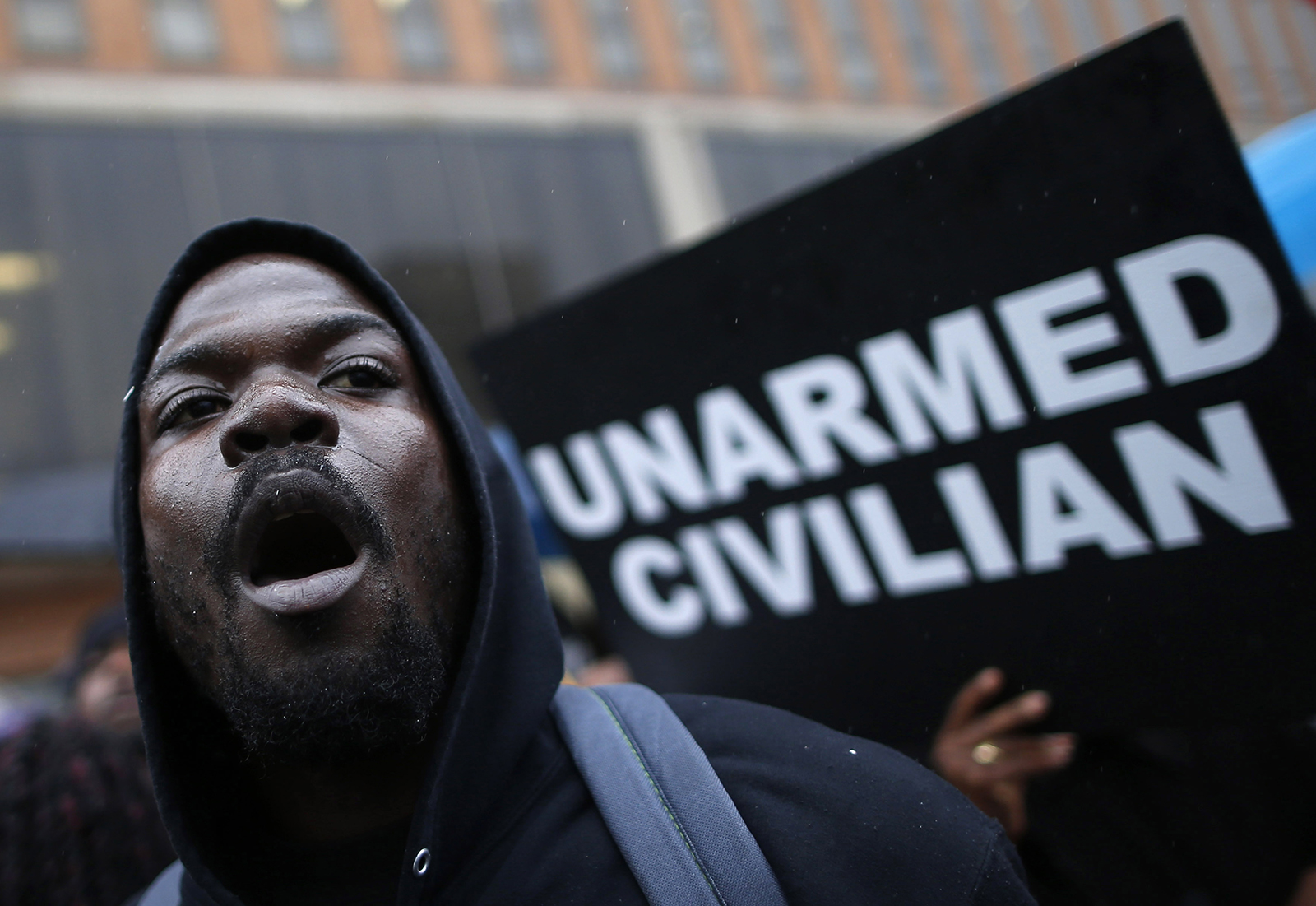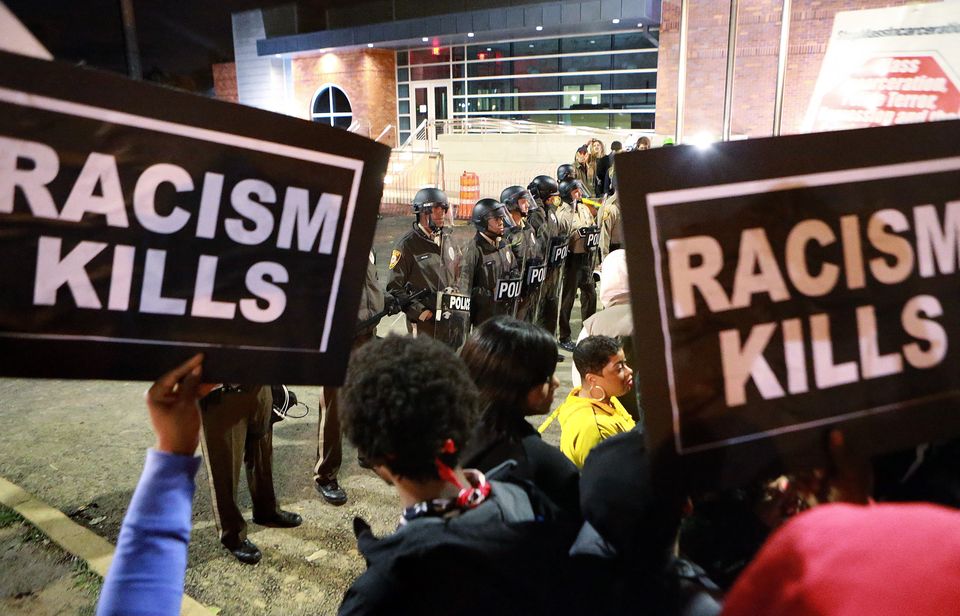
Seventeen demonstrators were arrested in a sit-in outside a QuikTrip here early Sunday as a weekend of "Ferguson October" demonstrations continued to spread out of the suburb of Ferguson and into the city of St. Louis.
"If we don't get it, shut it down," has become a key rallying cry for many activists, along with the defining chant of the Ferguson demonstrations: "Hands up, don't shoot."
Sunday morning's arrests capped a long Saturday of dissent that began with at least several hundred people marching through downtown St. Louis to protest shootings and racial inequality. That march finished without incident, as a smaller group of several dozen demonstrators marched on St. Louis Metropolitan Police headquarters.
Then, on Saturday night, hundreds of demonstrators gathered on the street in Ferguson where an unarmed black man, 18-year-old Michael Brown, was shot by white police officer Darren Wilson on Aug. 9, triggering persistent unrest.
The Ferguson protesters, joined by Michael Brown's mother, Lesley McSpadden, then marched more than 2 miles in the dark to the Ferguson Police Department, as a family representative asked the crowd to be peaceful and not incite the police.
After the group arrived at the Ferguson police station, the crowd massed around a line of police in their regular uniforms before holding a moment of silence, for 4 1/2 minutes, symbolizing each hour that Brown's body lay in the street after his death.
The demonstrators then began playing music on a mobile sound system, which was interrupted when one speaker took the microphone and pointed up at a single star visible in the sky.
"I want y'all to look up in the sky and say, Mike Brown! Mike Brown!" the man said, as the crowd chanted behind him and pointed at the sky.
The demonstration outside the police station, where a couple hundred people gathered, took on divergent moods as some demonstrators shouted at the police, others danced to music and many simply chatted with each other. The relaxed mood disturbed some participants, with one activist tweeting, "We haven't been out day after day for nine weeks so people can party in front of the Ferguson PD."
Some demonstrators then began calling for the protest to relocate to the Shaw neighborhood of St. Louis, where 18-year-old Vonderrit Myers Jr. was shot and killed by an off-duty St. Louis city police officer who was working a private security job for a local neighborhood. Police said Myers shot at the officer three times first, but representatives for Myers' family have insisted he was unarmed.
A march of at least several dozen demonstrators made a surprise stop at a QuikTrip near Shaw, a racially mixed neighborhood in south St. Louis.
The QuikTrip was a notable choice for the demonstrators; rioters looted and burned down a QuikTrip in Ferguson the day after Brown's death, and the empty convenience store parking lot became a gathering point for the ensuing protests that gripped the city.
At the QuikTrip near Shaw, the situation became more tense than earlier in the evening in Ferguson, where county police reported no property damage or arrests.
"We're going to march in! [There will be] no stealing or vandalizing of this property," one masked demonstration leader said on a bullhorn, according to live-streamed footage of the march. "We going to take it over!"
"Something changes when they get to the QuikTrip," St. Louis Metropolitan Police Chief Sam Dotson told the Los Angeles Times in an interview Sunday. "One of the clerks told me people with masks were pulling on the door trying to get in. You can imagine, if you're a QuikTrip employee [who knows what happened in Ferguson], you're probably pretty scared."
At that point, Dotson said — citing about 50 protesters blocking business and then sitting down and locking arms outside the store, cheering — police in riot gear cleared the demonstrators from the QuikTrip parking lot, pepper-spraying perhaps four to six people.
Officers gave the sitting demonstrators a last chance to leave without arrest, Dotson said, and many left. But 17 stayed and were arrested for failing to disperse. After clearing the parking lot, Dotson said someone threw a rock that hit one of his officers, although the officer wasn't hurt.
Dotson said his department is trying to take a relaxed approach to crowd control, in contrast to the strict and sometimes overwhelming displays of police force that came to define the early weeks of protest in Ferguson.
"Everybody has the right to be heard. That's what the First Amendment is," Dotson said, adding, "I'll do everything I can to support these events, but the takeover of a QuikTrip is not something I can support."
Ninety-nine percent of the demonstrators are peaceful, Dotson said. "But there are these agitators who work in the background and try to get the crowd to act up."
With a grand jury's decision expected in November over whether to indict Ferguson officer Wilson, Dotson said his agency is preparing for unrest in St. Louis, but he hoped for cooler heads to prevail.
"Ferguson is writing a narrative for St. Louis, for the country, and that narrative isn't done yet," Dotson said.
*
Meanwhile, Monica Davey and Alan Blinder reported for The New York Times about the diversity of participants and messages that emerged from Saturday's protests around St. Louis:
They came from places far from Ferguson, Mo., states like California, New York and Oregon. And while the story of a white police officer’s shooting of an unarmed black teenager in Ferguson in August was what drew throngs of people to the St. Louis area for a weekend of protest, some also came with sweeping messages about income inequality and the minimum wage, race relations, immigration policy and distrust about police procedures nationwide.
“The killing of innocent black youth is systemic,” said Adeline Bracey of Chicago, who marched here on Saturday in a crowd of demonstrators down the middle of Market Street, not far from the Gateway Arch. “It has to stop — everywhere.”
In the two months since the shooting death of Michael Brown, 18, in suburban Ferguson, a steady stream of demonstrations has often been local and personal, but the events this weekend, and expected to continue through Monday, were a test of the wider reach of efforts that have grown out of the case.
The result was a mix of races and ages. It brought a blur of signs with messages referring to the police officer who shot Mr. Brown, “Indict Darren Wilson Now,” but also broader notions, “Protest then vote.” Among an array of interests gathered: seminarians, voting rights advocates, college students and, perhaps most notably, a sizable contingent from labor unions, many wearing yellow T-shirts with the words: “Justice for all of us.”
“This is the perfect opportunity for organized labor to get out the message of equality in the workplace,” said Mike Louis, the president of the Missouri A.F.L.-C.I.O. “We’re here for economic justice.”
The mood during Saturday’s march was relaxed, though the police skirmished with protesters in the early hours of Sunday morning. During the Saturday march, police officers — in regular uniforms, not riot gear — stood watch, while others rode nearby on bicycles. Capt. Ronald S. Johnson of the Missouri State Highway Patrol, who led efforts to calm earlier protests in Ferguson, and Chief D. Samuel Dotson III of the St. Louis Metropolitan Police, greeted some in the crowd, chatting with passers-by.
Organizers said 3,000 people took part in Saturday’s rally. The police said they had no estimate of the crowd’s size. No arrests were made early in the day. But late into the night, arrests were reported as a small group of protesters staged a sit-in outside a convenience store in St. Louis and police officers in riot gear moved in, threatening arrests for those who did not leave. Demonstrators said the police used a chemical spray.
Chief Dotson said on Twitter that demonstrators had hurled rocks at police officers, and he said department officials had warned other QuikTrip stores that they could be protest sites.
“This behavior will not be tolerated,” the chief wrote.
In Ferguson, Mr. Brown’s mother, Lesley McSpadden, and other family members called for a peaceful protest late Saturday as they led a march toward the police station. When they arrived, officers in riot gear stood within sight, but there were no immediate conflicts between demonstrators and the authorities. Continue reading the main story Continue reading the main story Continue reading the main story
Soon after the crowd massed outside the station, organizers asked protesters to sit in silence on South Florissant Road for four and a half minutes.
The carefully organized protests come at a tense time, as a grand jury is deciding whether to indict Officer Wilson, who shot Mr. Brown on Aug. 9. Not far from where the morning’s march took place, the city hosted a St. Louis Cardinals postseason game on Saturday evening, as months of protests have put the region under a spotlight.
At times, sports teams have served as a cause for troubled communities to rally around, such as the Yankees in the aftermath of the 9/11 attacks, the New Orleans Saints after Hurricane Katrina, and the Boston Red Sox last year after the marathon bombing there.
The Cardinals’ manager, Mike Matheny, said he hoped that his team could be a healing force for the community. “We’ve got a lot of hurt that’s happened in the past all over the country, and baseball seems to be part of that healing process,” he said. “We have some hurt in our community right now, and hopefully this playoff baseball — and baseball in general — can help that healing process here as well.”
That did not appear to be the case outside Busch stadium. There was a small, but vocal crowd of about 30 protesters stationed between the ballpark and a fan zone that had been set up across the street. Before the game, they displayed a few signs and shouted chants — “Let’s go, justice!” and “While you watch the game, our people die!” — as fans filed past to enter.
The protesters were speaking out over the divide between white and black America, according to one of the leaders, who identified himself as Rockit Ali. “I just watched a group of people over there sing ‘Take Me Out To The Ballgame,’ and sing and smile,” he said. “This is not a happy time. They come here and watch a baseball game while we die, we go out and get pepper sprayed and hit with tear gas for peacefully protesting.”
While there were police officers stationed at a nearby street corner, there did not appear to be any near the demonstrators.
As fans filed past, few paid any attention to their chants. “I wish they’d go home,” said Amanda Rogers of Springfield, Mo., as she walked past with her husband, Casey.
As recently as Thursday, demonstrators marched through the streets in the Shaw neighborhood of St. Louis, after a white, off-duty officer killed a black teenager, Vonderrit Myers Jr., a day earlier. Police say Mr. Myers opened fire on the police officer, but his family says he had no gun. In the protests that followed, eight people were arrested and a police officer was injured, the authorities said; police used pepper spray on the crowd. On Friday night, people demonstrated in Shaw as well as Ferguson; the authorities reported no arrests.
Virgil Smith, who is from Lafayette, Ind., and attended Saturday’s march, said the evolution of demonstrations over the past two months — from unplanned gatherings in Ferguson that sometimes turned violent to coordinated protests in the heart of St. Louis — was natural.
“You have a lot of different strands of the American community coming together,” said Mr. Smith, 49. “Early on, you had people who might not be interested in making a political statement at all. Here, you’ve got a more considered, political effort.”
At an afternoon rally, Alexis Templeton said the demonstrations would continue until the police heeded their message.
“We aren’t going anywhere until you stop killing us,” said Ms. Templeton, who said she had been arrested three times during the protests in recent months. “You will stop killing us.”
3 WAYS TO SHOW YOUR SUPPORT
- Log in to post comments













